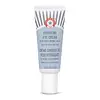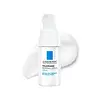First Aid Beauty Hydrating Eye Cream with Hyaluronic Acid Versus La Roche-Posay Toleriane Dermallergo Eye Cream
What's inside
What's inside
 Key Ingredients
Key Ingredients

 Benefits
Benefits

 Concerns
Concerns

No concerns
 Ingredients Side-by-side
Ingredients Side-by-side

Water
Skin ConditioningEthylhexyl Olivate
Skin ConditioningPrunus Armeniaca Kernel Oil
MaskingButylene Glycol
HumectantCetyl Alcohol
EmollientGlycerin
HumectantMangifera Indica Seed Butter
Skin ConditioningSodium Acrylates Crosspolymer-2
AbsorbentCetyl Phosphate
EmulsifyingCaffeine
Skin ConditioningSqualane
EmollientHyaluronic Acid
HumectantPanthenol
Skin ConditioningCucumis Sativus Fruit Extract
EmollientAvena Sativa Bran Extract
AbrasiveAloe Barbadensis Leaf Juice
Skin ConditioningCamellia Sinensis Leaf Extract
AntimicrobialColloidal Oatmeal
AbsorbentChrysanthemum Parthenium Extract
Skin ConditioningGlycyrrhiza Glabra Root Extract
BleachingCitrus Aurantium Dulcis Peel Extract
Emulsion StabilisingCaprylic/Capric Triglyceride
MaskingCaprylyl Glycol
EmollientSodium Phytate
Sodium Polyglutamate
HumectantC20-22 Alkyl Phosphate
Emulsifying1,2-Hexanediol
Skin ConditioningC20-22 Alcohols
Emulsion StabilisingHydroxyacetophenone
AntioxidantPropanediol
SolventPhenoxyethanol
PreservativePotassium Hydroxide
BufferingWater, Ethylhexyl Olivate, Prunus Armeniaca Kernel Oil, Butylene Glycol, Cetyl Alcohol, Glycerin, Mangifera Indica Seed Butter, Sodium Acrylates Crosspolymer-2, Cetyl Phosphate, Caffeine, Squalane, Hyaluronic Acid, Panthenol, Cucumis Sativus Fruit Extract, Avena Sativa Bran Extract, Aloe Barbadensis Leaf Juice, Camellia Sinensis Leaf Extract, Colloidal Oatmeal, Chrysanthemum Parthenium Extract, Glycyrrhiza Glabra Root Extract, Citrus Aurantium Dulcis Peel Extract, Caprylic/Capric Triglyceride, Caprylyl Glycol, Sodium Phytate, Sodium Polyglutamate, C20-22 Alkyl Phosphate, 1,2-Hexanediol, C20-22 Alcohols, Hydroxyacetophenone, Propanediol, Phenoxyethanol, Potassium Hydroxide
Water
Skin ConditioningGlycerin
HumectantButylene Glycol
HumectantPropanediol
SolventSqualane
EmollientButyrospermum Parkii Butter
Skin ConditioningPentylene Glycol
Skin ConditioningNiacinamide
SmoothingCellulose
AbsorbentZea Mays Starch
AbsorbentPolysorbate 20
EmulsifyingSalvia Miltiorrhiza Root Extract
Skin ConditioningGlyceryl Acrylate/Acrylic Acid Copolymer
HumectantSphingomonas Ferment Extract
Skin ConditioningAmmonium Polyacryloyldimethyl Taurate
Emulsion StabilisingHydroxyacetophenone
AntioxidantCitric Acid
BufferingTrisodium Ethylenediamine Disuccinate
Acetyl Dipeptide-1 Cetyl Ester
Skin ConditioningWater, Glycerin, Butylene Glycol, Propanediol, Squalane, Butyrospermum Parkii Butter, Pentylene Glycol, Niacinamide, Cellulose, Zea Mays Starch, Polysorbate 20, Salvia Miltiorrhiza Root Extract, Glyceryl Acrylate/Acrylic Acid Copolymer, Sphingomonas Ferment Extract, Ammonium Polyacryloyldimethyl Taurate, Hydroxyacetophenone, Citric Acid, Trisodium Ethylenediamine Disuccinate, Acetyl Dipeptide-1 Cetyl Ester
 Reviews
Reviews

Ingredients Explained
These ingredients are found in both products.
Ingredients higher up in an ingredient list are typically present in a larger amount.
Butylene Glycol (or BG) is used within cosmetic products for a few different reasons:
Overall, Butylene Glycol is a safe and well-rounded ingredient that works well with other ingredients.
Though this ingredient works well with most skin types, some people with sensitive skin may experience a reaction such as allergic rashes, closed comedones, or itchiness.
Learn more about Butylene GlycolGlycerin is already naturally found in your skin. It helps moisturize and protect your skin.
A study from 2016 found glycerin to be more effective as a humectant than AHAs and hyaluronic acid.
As a humectant, it helps the skin stay hydrated by pulling moisture to your skin. The low molecular weight of glycerin allows it to pull moisture into the deeper layers of your skin.
Hydrated skin improves your skin barrier; Your skin barrier helps protect against irritants and bacteria.
Glycerin has also been found to have antimicrobial and antiviral properties. Due to these properties, glycerin is often used in wound and burn treatments.
In cosmetics, glycerin is usually derived from plants such as soybean or palm. However, it can also be sourced from animals, such as tallow or animal fat.
This ingredient is organic, colorless, odorless, and non-toxic.
Glycerin is the name for this ingredient in American English. British English uses Glycerol/Glycerine.
Learn more about GlycerinHydroxyacetophenone is antioxidant with skin conditioning and soothing properties. It also boosts the efficiency of preservatives.
This ingredient is not irritating or sensitizing.
Propanediol is an all-star ingredient. It softens, hydrates, and smooths the skin.
It’s often used to:
Propanediol is not likely to cause sensitivity and considered safe to use. It is derived from corn or petroleum with a clear color and no scent.
Learn more about PropanediolSqualane is an emollient that helps the skin hold onto moisture. It's an oily liquid that occurs naturally in certain types of fish and plant oils.
Because squalane boosts hydration in the skin, it also comes with plenty of benefits: it is an antioxidant and can help fight free radicals and skin damage. Squalane is also found to have a detoxifying effect when applied.
Squalane comes from squalene, which occurs naturally within the sebum of our skin. It is one of the oils our skin produces to keep itself hydrated. Squalane is the hydrogenated version of squalene and has a longer shelf life.
Research shows that squalane is non-irritating (even at 100% concentration).
In general, it's a fantastic ingredient. It does a great job at hydrating the skin, and it's suitable for those with sensitive skin.
The source of squalane may impact malassezia / fungal acne. This is because olive oil derived squalane can contain impurities such as fatty acids and plant waxes. Sugarcane derived squalane is recommended for anyone with malassezia concerns.
Is squalane vegan?
This depends on the source. Squalane can be derived from both plants and animals. Most squalane used in skincare comes from plants.
Please note: the source of squalane is only known if disclosed by the brand. We recommend reaching out to the brand if you have any questions about their squalane.
Read more about squalene with an "e".
Is squalane an oil?
Squalane is often called an oil, but it’s technically not; it’s a hydrocarbon, meaning it’s only made of carbon and hydrogen, unlike true oils which are triglycerides made of fatty acids and glycerol.
The term “oil-free” isn’t regulated, so companies can define it however they want. Some exclude all oils, while others just avoid mineral oil or comedogenic oils.
While some people avoid oils thinking they cause breakouts, the right kind of oil (or oil-like ingredient like squalane) can actually help balance and hydrate your skin. It’s worth testing out simple oils or squalane to see what works best for your skin.
Learn more about SqualaneWater. It's the most common cosmetic ingredient of all. You'll usually see it at the top of ingredient lists, meaning that it makes up the largest part of the product.
So why is it so popular? Water most often acts as a solvent - this means that it helps dissolve other ingredients into the formulation.
You'll also recognize water as that liquid we all need to stay alive. If you see this, drink a glass of water. Stay hydrated!
Learn more about Water